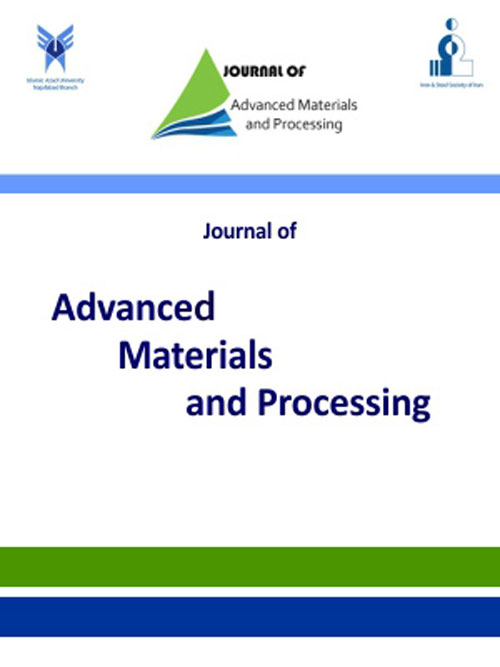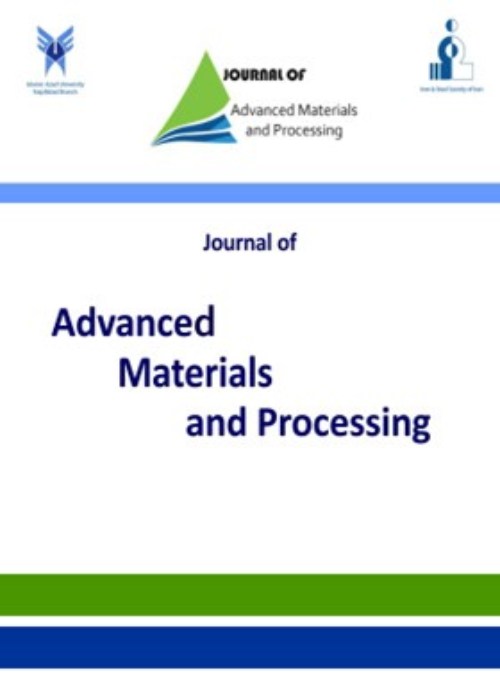فهرست مطالب

Journal of advanced materials and processing
Volume:4 Issue: 3, Summer 2016
- تاریخ انتشار: 1395/07/27
- تعداد عناوین: 8
-
-
Editorial BoardPages 1-2
-
Pages 3-13IIn this work, cobalt-based alloy/ nano bioactive glass (NBG) composites with 10, 15 and 20 wt% NBG were prepared and their bioactivity after immersion in simulated body fluid (SBF) for 1 to 4 weeks was studied. The scanning electron microscopy images of two- step sintered composites revealed a relatively dense microstructure the density of which decreased with the increase in the NBG amount. Microstructural analysis as well as energy dispersive X-ray analysis (EDX) revealed that after 1 week of immersion in SBF, a small amount of calcium phosphate phases precipitates on the surface of the composite samples. After 2 weeks of immersion, a considerable amount of cauliflower-like shaped precipitations was observed on the surface of composites. The observed peaks in the Fourier transform infrared (FTIR) spectroscopy of the composite samples in SBF immersed for 4 weeks were assigned to hydroxyapatite. Therefore, a hydroxyapatite layer has been possibly formed on the surface of the composite samples during immersion in SBF. Cell culture results indicate that unlike the Co-based alloy, the Co-based/NBG composites are bioactive and bone cells could be vivid and grow on their surfaces, promising their possibility for implant applications.Keywords: Biomaterials, Sintering, Nano bioactive glass Response Surface, Osteoblast response
-
Pages 14-21The aim of this study was to synthesis of glass ionomer-silk fiber composite and to evaluate the effect of adding natural degummed silk fiber on the mechanical properties of glass ionomer cement (GIC). For this purpose, natural degummed silk fibers with 1 mm in length and 13-16 µm in diameter were added to the ceramic component of a commercial glass ionomer cement in 1, 3 and 5 wt. %. Compressive strength (CS), three-point flexural strength (FS) and diametral tensile strength (DTS) of the prepared glass ionomer-silk fiber were measured. Analysis of variance (ANOVA) was used to compare the obtained results. Moreover, SEM technique was used for investigation of the surface morphology of as-prepared composite and fractured area. The results showed that the highest compressive strength, flexural strength and diametral tensile strength were obtained using 3, 3 and 5 wt. % of silk fiber, respectively. However, at 3 wt. % silk fiber, all three measures of strength exhibited a significant increase compared to the commercial GIC. Therefore, it can be suggested that the addition of 3 wt. % silk fiber to the ceramic component of GIC is desired for dental restorations and orthopedic implant applications, where the maximum strength in all three modes of loading would be beneficial.Keywords: Silk fiber, Glass ionomer cement, Mechanical properties, Composite
-
Pages 22-32The nanostructures of Fe2O3 have been synthesized applying sour cherry juice and iron chloride as a low-cost and eco-friendly method at ambient conditions. Sour cherry juice has been used as a surfactant and the kind of surfactant had an important effect on the size and morphology of the products. The effect of sour cherry juice concentration and calcination temperature on the morphologies of Fe2O3 nanostructures has been investigated. The prepared nanoparticles were subjected to X-ray diffraction (XRD) analysis, field emission scanning electron microscopy (FE-SEM), and vibrating sample magnetometer (VSM) system. The powder X-ray diffraction analysis confirmed that Fe2O3 nanostructures are in Rhombohedral and Cubic phases. The average crystalline size estimated by the Williamson-hall method was about 13-32 nm for all samples. Various morphologies were also obtained by changing the amount of sour cherry juice. The saturation magnetization increased with the growth of crystals.Keywords: sour cherry juice, Fe2O3 nanostructure, Green synthesis, magnetism characterization
-
Pages 33-42Layered alloys and composite materials have become an increasingly popular in industrial development. The roll bonding (RB) process, as a solid phase method of bonding, has been widely used in manufacturing large layered strips. In this study, aluminum alloy (AA 5083) strips were roll bonded at warm and cold temperatures. The effects of the rolling parameters such as the amount of plastic deformation by rolling and rolling temperature that create successful bonds on the bond strength and the threshold deformation between two layer strips of AA 5083/ AA 5083 were investigated. The bond strength was evaluated by the peeling test. It was found that by increasing the rolling temperature or thickness reduction, the peel strengths of the bonds increased and successful bonds with higher strength were created. Also, the threshold thickness reduction decreased with increasing the rolling temperature. Moreover, the interfaces of laminates were studied by scanning electron microscopy (SEM) in order to investigate the bonding quality.Keywords: Roll bonding, solid welding, Bond strength, Peel testing
-
Pages 43-51ZnO nanorods with various lengths were synthesized by a two-stage route (by changing the time of growth between 0-240 min) and were characterized using XRD, SEM, UVVis and PL techniques. The SEM and XRD results confirmed a fast growth of (0 0 2) plane in the preferential longitudinal orientation, in contrast to lateral growth and therefore, by increasing the time of hydrothermal growth, nanorods with higher aspect ratios are obtained. Naturally, by increasing the length of nanorods, not only the average transmittance in both near ultraviolet and visible ranges is decreased, but also the PL peaks are red-shifted and extinct. Finally, ultra-violet photodetection of the samples shows that higher active surface area (with respect to the time of growth) is appropriate for photo-induced interactions leading to higher UV-sensitivity.Keywords: ZnO nanorod, Optical characteristics, ultra, violet photodetection
-
Pages 52-58The mechanical properties of microscopic particles have been a heated research object for it takes the deformation of micro-beads in the microfluidic environment into account. Sufficient knowledge on mechanical properties of micro-beads would lead to better device design and application for cell mechanics, tissue engineering, etc. The physical properties of alginate beads were examined both in normal condition and under compression, to illustrate its mechanical stability and to calculate the shear modulus through Hertz model. Furthermore, the modeling of physicochemical variation of micro-beads under the ultrasonic thermal effect was performed. The temperature rose simultaneously with ultrasonic thermal effect. The shear module and diameter of micro-beads changed with the increase of temperature in the solution. The descriptive model and the predictive model for the relationship between temperature and the module/diameter of micro-beads were established, and the validation process presented the effectiveness of the models.Keywords: Thermal effect, Modeling, Alginate, Shear module
-
Pages 59-68In this paper the feasibility of NbAl3/Al2O3 nanocomposite formation through mechanochemical reaction between Al and Nb2O5 and the effect of mechanical activation on the kinetic and reaction mechanism were investigated. Structural and phase evolution during mechanical alloying were studied by employing transmission electron microscopy (TEM), X-ray diffraction (XRD) and differential thermal analysis (DTA) techniques. It was found from the results that the reduction of Nb2O5 by Al takes place in an explosive mode and after 450 min of mechanical alloying leading to the formation a microstructure consisting of NbAl3 matrix and nanocrystalline Al2O3 particles. The results also showed that heating the as-blended powder mixture of Nb2O5 and Al, leads to the formation of NbAl3/Al2O3 composite through two exothermic reaction; A thermite reaction at 880 °C followed by the synthesis of NbAl3 intermetallic at 944 °C. The mechanical activation of Nb2O5 and Al powder for 5h decreased the formation temperature of NbAl3/Al2O3 from 944 °C to 625 °C. Five isoconversional methods, of Kissinger-Akahira-Sunose, Tang, Flynn-Wall-Ozawa, Starink and Friedman were used to determine the activation energy, Eα, for NbAl3/Al2O3 formation reaction and its variation with conversion degree α. The results showed that these methods lead to similar or comparable values of Eα.Keywords: Nanostructures, Intermetallic compounds, DTA, Kinetic study, Niobium


